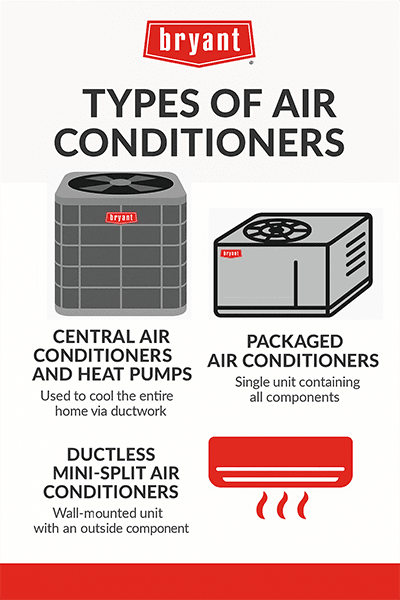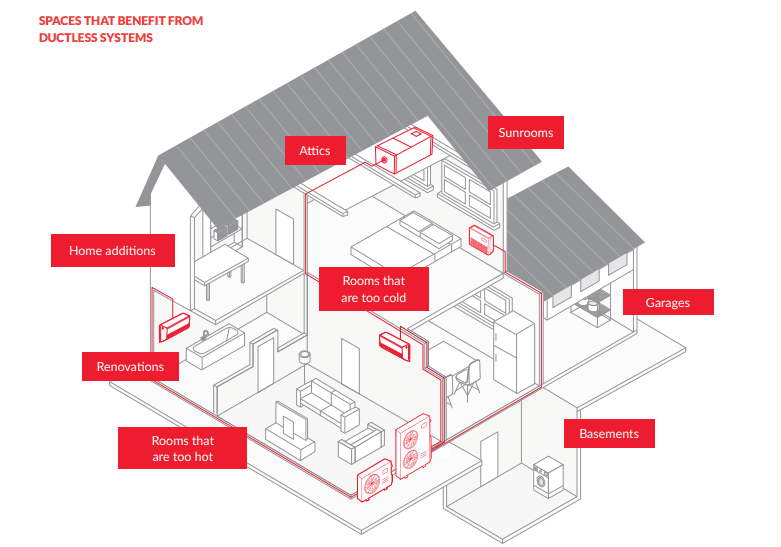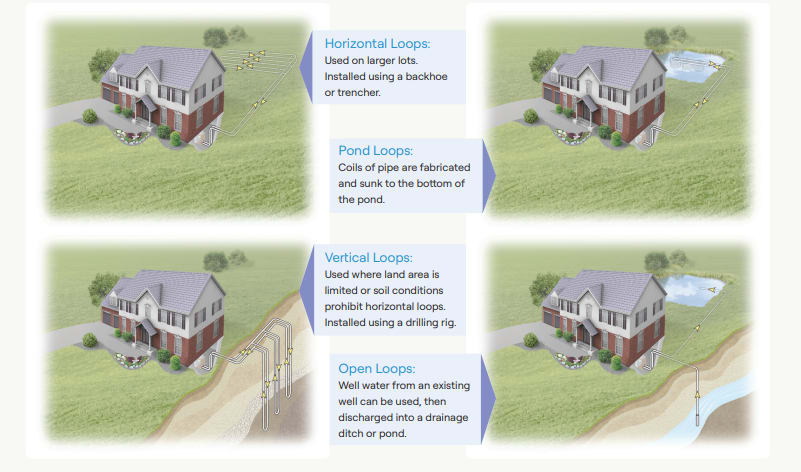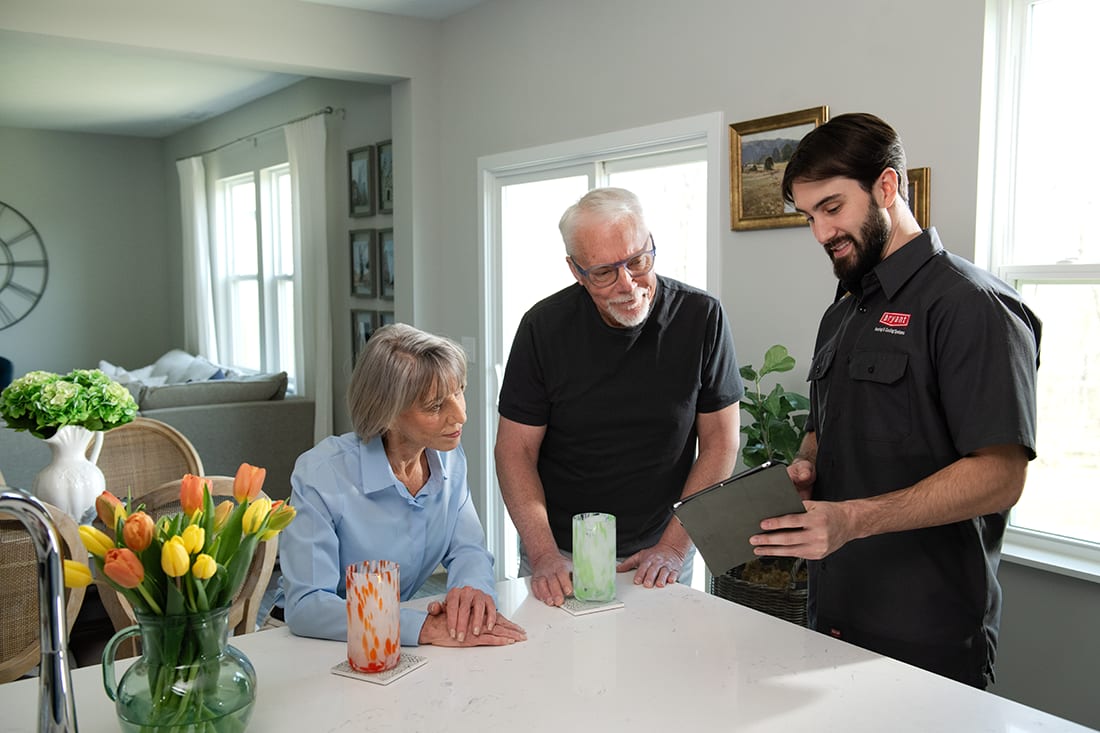About The Author: Travis Baugh is a Digital Brand Marketing Manager for Bryant, where he creates clear, helpful content to guide homeowners through heating, cooling, and indoor air quality decisions. His goal is to empower readers with the knowledge they need to choose the right comfort solutions for their home—confidently and comfortably.
Types of Air Conditioners: A Comprehensive Guide
By Travis Baugh
Choosing the right air conditioner for your home can significantly enhance your comfort and energy efficiency. In this comprehensive guide, we will explore the most common types of AC systems, including central air conditioners, packaged air conditioners, ductless mini split air conditioners, and geothermal heat pumps.
Understanding Air Conditioning Systems

Air conditioners play a crucial role in maintaining comfortable indoor environments, especially during the sweltering summer months. At their core, these systems operate by removing heat and humidity from the air inside your home, thereby providing a cooler atmosphere. The process begins with AC refrigerant, a fluid that circulates through the system, absorbing heat from the indoor air and transferring it outside. This cycle of evaporation and condensation is what ultimately cools your living space.
The importance of air conditioning in residential areas cannot be overstated. Not only does it enhance comfort, but it also promotes better air quality by filtering out dust, allergens, and other pollutants. This is particularly beneficial for individuals with respiratory issues, making a well-functioning air conditioning system an essential component of a healthy home environment.
Understanding the key AC parts can help homeowners appreciate its functionality. The main parts include the compressor, condenser, evaporator coil, and expansion valve. The compressor circulates the refrigerant, while the condenser releases the absorbed heat outdoors. The evaporator coil cools the air, and the expansion valve regulates the refrigerant flow. Each component works in harmony to ensure efficient cooling, making it vital to invest in a reliable air conditioning system, like those offered by Carrier, to guarantee optimal performance and energy efficiency.
Central Air Conditioners And Heat Pumps
Central air conditioners or heat pumps are a popular choice for cooling entire homes, providing consistent temperatures and enhanced comfort. These systems work by distributing cooled air through a network of ducts, ensuring that every room in your house can maintain a comfortable atmosphere. Learn more about how air conditioners work.
One of the primary benefits of central air conditioning and heat pumps is its ability to efficiently manage indoor climates, making it ideal for an entire home homes. Additionally, central air conditioners can help improve indoor air quality by filtering out allergens and pollutants, which is a significant advantage for families with allergy sufferers.
When considering AC installation, several factors come into play. Central air conditioning units require adequate space for both the indoor and outdoor components, along with professional HVAC installation to ensure proper ductwork and airflow. It’s essential to have your local Bryant dealer assess the size of your home and the cooling load needed to select the right unit. Additionally, modifications to existing ductwork may be necessary to optimize performance.
Energy efficiency is another critical aspect of central air conditioners. Look for units with high Seasonal Energy Efficiency Ratio (SEER2) and Energy Efficiency Ratio (EER2) ratings, which indicate how effectively the system uses energy to cool your home. Bryant offers a range of models equipped with advanced features such as variable-speed compressors and smart thermostats, which can significantly lower energy consumption and reduce cooling bills. By investing in a high-efficiency central air conditioning system, you not only enjoy consistent comfort but also contribute to a more sustainable environment.
Central air conditioners and heat pumps come in a wide variety of sizes. Learn more about AC sizes: 2 ton, 3 ton, 4 ton, and 5 ton.

Packaged Air Conditioners
Packaged air conditioners are an all-in-one HVAC solution designed to provide efficient cooling while saving space. Unlike split air conditioning systems that have separate indoor and outdoor units, packaged units house all essential components—compressor, coils, and air handler—within a single outdoor cabinet. This makes them ideal for homes or businesses with limited indoor space, as they can be installed on rooftops or next to homes for a streamlined setup.
One of the key benefits of packaged air conditioners is their ease of installation and AC maintenance. Since all components are housed together, they require less ductwork and take up less space, making them a practical choice for homes without basements or attics. Additionally, their compact design simplifies air conditioning service, allowing technicians to access all parts in one location.
Packaged units also offer energy efficiency and reliable performance. Many models are equipped with high Seasonal Energy Efficiency Ratios (SEER2) and advanced features such as variable-speed fans and multi-stage compressors, ensuring consistent comfort while reducing energy consumption. Some units even include heating options, such as gas or electric heat, providing year-round climate control.
Whether you need cooling for a residential or commercial space, packaged air conditioners deliver a powerful, space-saving solution. To find the right unit for your needs, connect with your local Bryant dealer for expert guidance and professional installation.
Ductless Mini Split Air Conditioners
Ductless mini split air conditioners operate by using two main components: an outdoor condenser and one or more indoor air-handling units. Unlike traditional air conditioning systems that rely on ducts to distribute cooled air, mini-split systems provide targeted cooling directly to specific areas or rooms. This is achieved through a small refrigerant line that connects the outdoor unit to the indoor units, allowing for efficient temperature control without the need for extensive ductwork.
One of the most significant advantages of ductless mini-split air conditioners is their flexibility. Homeowners can choose to install multiple indoor units to cater to different spaces, making it easy to adjust the temperature in rooms based on individual preferences. This zoning capability not only enhances comfort but also contributes to energy savings, as it allows for cooling only in occupied areas. Additionally, many modern mini split systems feature high-efficiency ratings, which can lead to reduced cooling bills and a smaller environmental footprint.
Ideal scenarios for installing ductless mini-split systems include homes without existing ductwork, additions where extending ducting would be impractical, or spaces with unique cooling needs, such as sunrooms or converted attics. These types of AC systems may also be an excellent
HVAC option for older homes where installing traditional air conditioning may be challenging. With their ability to provide efficient and flexible cooling solutions, ductless mini split air conditioners are an excellent choice for enhancing residential comfort. Learn more about two types of ductless systems - wall AC units and garage AC units.

Geothermal Heat Pumps: An Alternative To Air Conditioners
While geothermal heat pumps are not traditional air conditioners, they provide highly efficient cooling by leveraging the stable temperatures underground. Unlike conventional AC units that rely on outdoor air for heat exchange, geothermal systems use a series of buried pipes (called a ground loop) to transfer heat between your home and the earth. This process makes them one of the most energy-efficient cooling solutions available.
In cooling mode, a geothermal heat pump works similarly to a standard air conditioner, extracting heat from indoor air and transferring it underground. Because ground temperatures remain relatively constant throughout the year—typically between 50-60°F—geothermal systems operate more efficiently than air-source heat pumps, especially in extreme climates. This translates to lower energy costs and consistent indoor comfort with reduced strain on the system. They also can operate in heating mode, providing heating for your home.
Beyond efficiency, geothermal heat pumps offer long-term durability and environmental benefits. The underground loop system can last 50+ years, while the indoor unit typically lasts 20-25 years, significantly outlasting conventional HVAC systems. Additionally, geothermal cooling produces fewer greenhouse gas emissions, making it a sustainable choice for homeowners looking to reduce their carbon footprint.
Though the initial installation cost can be higher than traditional split AC units, the long-term energy savings, reliability, and eco-friendliness make geothermal heat pumps a smart investment. To learn if a geothermal system is right for your home, consult with a Bryant dealer for expert advice and professional installation.

Talk To A Bryant Dealer To Find The Right Type of Air Conditioner For Your Home
Your local Bryant dealer can help you discover the best air conditioner for your home. With expert guidance, they’ll assess your space and perform the AC replacement , whether it’s a central AC, packaged AC, geothermal or ductless solution. Connect with your local Bryant dealer today to ensure efficient, reliable cooling tailored to your home.

FAQs on Types of Air Conditioners
The best type of air conditioner depends on your home's layout, budget, and cooling needs. Central AC systems are ideal for whole-home comfort, while ductless mini splits offer flexible, energy-efficient solutions for homes without existing ductwork.
The three main types of residential AC systems are central air conditioners, packaged systems, and ductless mini splits. Central systems use ductwork to distribute air, packaged units combine all components in one outdoor cabinet, and ductless systems offer targeted cooling without ducts.
Learn More About Air Conditioners
- Learn how does air conditioning work
- Find out what is an inverter air conditioner
- Understand the value of AC tune ups
- Discover the factors in choosing what size air conditioner you need
- Find out how long do AC units last?
- Discover the difference in a heat pump vs air conditioner
- Find out what temperature to set air conditioner in summer


